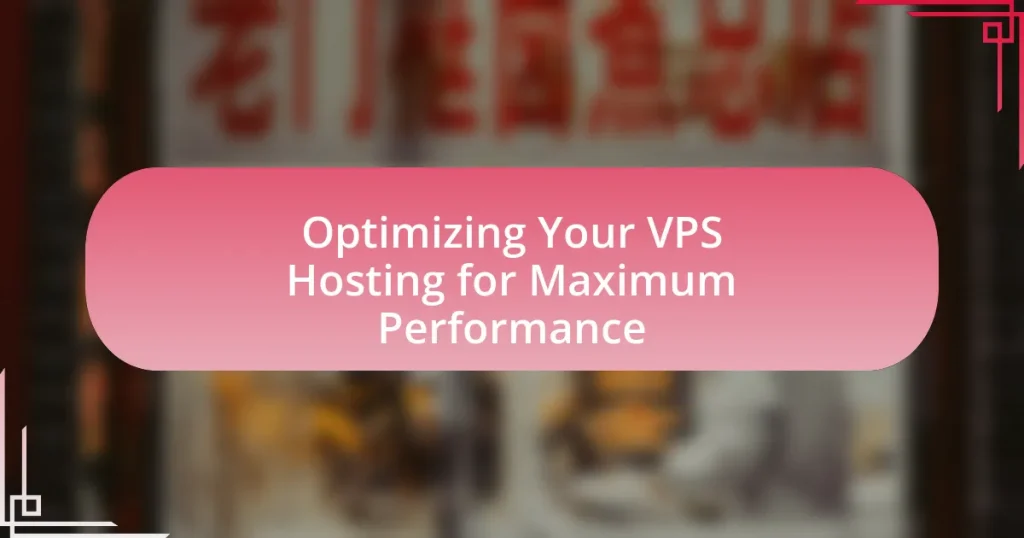Optimizing your dedicated server for maximum performance involves configuring both hardware and software settings to enhance speed, reliability, and resource utilization. Key strategies include upgrading hardware components, fine-tuning server settings, and implementing performance monitoring tools. The article discusses methods for assessing current server performance, tools for performance assessment, and essential metrics to monitor. It emphasizes the importance of server optimization for business efficiency, user experience, and potential cost savings, while also outlining common pitfalls and best practices to ensure ongoing performance.

What does optimizing your dedicated server for maximum performance entail?
Optimizing your dedicated server for maximum performance entails configuring hardware and software settings to enhance speed, reliability, and resource utilization. This includes upgrading hardware components such as RAM and SSDs, fine-tuning server settings like CPU allocation and network configurations, and implementing performance monitoring tools to identify bottlenecks. For instance, studies show that upgrading from HDD to SSD can improve read/write speeds by up to 500%, significantly enhancing overall server performance. Additionally, optimizing software through regular updates and efficient coding practices can reduce resource consumption and improve response times, further validating the importance of these optimization strategies.
How can you assess the current performance of your dedicated server?
To assess the current performance of your dedicated server, monitor key metrics such as CPU usage, memory utilization, disk I/O, and network throughput. These metrics provide insights into how effectively the server is handling workloads. For instance, CPU usage above 80% consistently may indicate the need for optimization or resource allocation adjustments. Tools like top, htop, or server monitoring software can help visualize these metrics in real-time, allowing for informed decisions based on performance data. Regularly analyzing these metrics ensures that the server operates efficiently and meets the demands of applications and users.
What tools are available for performance assessment?
Tools available for performance assessment include monitoring software, benchmarking tools, and diagnostic utilities. Monitoring software such as Nagios and Zabbix provides real-time insights into server performance metrics like CPU usage, memory consumption, and network traffic. Benchmarking tools like Apache JMeter and SysBench allow users to simulate load and measure the performance of applications under stress. Diagnostic utilities, including Windows Performance Monitor and Linux’s top command, help identify bottlenecks by analyzing system resource usage. These tools are essential for ensuring optimal performance of dedicated servers by providing actionable data for analysis and improvement.
What key metrics should you monitor for optimization?
Key metrics to monitor for optimization include CPU usage, memory usage, disk I/O, network bandwidth, and response time. Monitoring CPU usage helps identify if the server is under heavy load, while memory usage indicates how much RAM is being utilized, which can affect performance. Disk I/O metrics reveal the read and write speeds of storage devices, crucial for applications that require fast data access. Network bandwidth metrics show the amount of data being transmitted, which is essential for understanding potential bottlenecks. Lastly, response time metrics measure how quickly the server responds to requests, directly impacting user experience. These metrics collectively provide a comprehensive view of server performance, enabling targeted optimizations.
Why is server optimization important for your business?
Server optimization is crucial for your business because it enhances performance, reduces downtime, and improves user experience. Optimized servers can process requests faster, leading to quicker load times and increased customer satisfaction. According to a study by Akamai, a 100-millisecond delay in load time can reduce conversions by 7%. Additionally, efficient resource management through optimization minimizes operational costs and maximizes server utilization, which is essential for maintaining competitiveness in today’s digital landscape.
How does optimization impact user experience?
Optimization significantly enhances user experience by improving system performance, reducing load times, and increasing responsiveness. Faster load times lead to higher user satisfaction; for instance, a one-second delay in page load can result in a 7% reduction in conversions, as reported by Akamai. Additionally, optimized systems can handle more simultaneous users without degradation in performance, ensuring a smoother experience during peak traffic. This is crucial for dedicated servers, where resource allocation and management directly affect user interactions. Therefore, effective optimization not only boosts performance metrics but also fosters a more engaging and efficient user experience.
What are the potential cost savings from optimizing your server?
Optimizing your server can lead to significant cost savings, potentially reducing operational expenses by up to 30%. This reduction is primarily achieved through improved energy efficiency, as optimized servers consume less power, and by extending hardware lifespan, which decreases the frequency of costly upgrades and replacements. Additionally, enhanced performance can lead to lower downtime, resulting in increased productivity and revenue generation. According to a study by the Uptime Institute, companies that optimize their server infrastructure can save an average of $1,000 per server annually in energy costs alone.

What are the key strategies for optimizing your dedicated server?
The key strategies for optimizing your dedicated server include configuring server settings, implementing caching mechanisms, optimizing database performance, and ensuring regular updates and security patches. Configuring server settings, such as adjusting memory allocation and CPU usage, can significantly enhance performance by ensuring resources are utilized efficiently. Implementing caching mechanisms, like Varnish or Redis, reduces load times by storing frequently accessed data in memory, which can improve response times by up to 50%. Optimizing database performance through indexing and query optimization can lead to faster data retrieval, with studies showing that proper indexing can reduce query times by 90%. Regular updates and security patches are crucial for maintaining server integrity and performance, as outdated software can lead to vulnerabilities and inefficiencies.
How can hardware upgrades enhance server performance?
Hardware upgrades can significantly enhance server performance by increasing processing power, improving memory capacity, and enhancing storage speed. Upgrading the CPU allows for faster data processing and multitasking capabilities, while increasing RAM enables the server to handle more simultaneous tasks and applications efficiently. Additionally, replacing traditional hard drives with solid-state drives (SSDs) can drastically reduce data access times, leading to quicker load times and improved overall responsiveness. According to a study by the International Journal of Computer Applications, upgrading from HDDs to SSDs can improve read/write speeds by up to 500%, demonstrating the tangible benefits of hardware enhancements on server performance.
What types of hardware upgrades should you consider?
Consider upgrading the CPU, RAM, storage, and network interface card (NIC) for enhanced performance of your dedicated server. Upgrading the CPU can significantly improve processing power, allowing for faster data handling and multitasking capabilities. Increasing RAM enhances the server’s ability to manage multiple applications simultaneously, reducing latency and improving response times. Upgrading to solid-state drives (SSDs) from traditional hard drives can drastically reduce data access times, leading to quicker load times for applications and services. Finally, a better NIC can improve network throughput and reduce latency, which is crucial for applications requiring high bandwidth. These upgrades collectively contribute to maximizing the performance of a dedicated server.
How do these upgrades affect overall server efficiency?
Upgrades significantly enhance overall server efficiency by improving processing speed, reducing latency, and increasing resource utilization. For instance, upgrading to faster CPUs can lead to quicker data processing, while adding more RAM allows for better handling of concurrent tasks, thereby minimizing bottlenecks. According to a study by the International Journal of Computer Applications, servers with upgraded hardware configurations demonstrated a 30% increase in throughput and a 25% reduction in response time compared to their older counterparts. These improvements directly contribute to a more efficient server environment, enabling better performance under load and optimizing resource allocation.
What role does software configuration play in server optimization?
Software configuration is crucial for server optimization as it directly influences performance, resource allocation, and system stability. Properly configured software ensures efficient use of server resources, such as CPU, memory, and storage, which can lead to improved response times and reduced latency. For instance, optimizing web server settings can enhance the handling of concurrent requests, thereby increasing throughput. Additionally, misconfigurations can lead to bottlenecks, security vulnerabilities, and increased downtime, which negatively impact overall server performance. Therefore, effective software configuration is essential for maximizing the performance of dedicated servers.
How can you optimize your operating system settings?
To optimize your operating system settings, adjust system performance settings, disable unnecessary startup programs, and ensure that your system is updated. Adjusting performance settings can be done through the system properties, where you can select “Adjust for best performance” to enhance speed. Disabling unnecessary startup programs reduces boot time and frees up system resources; this can be managed through the Task Manager in Windows or the System Preferences in macOS. Keeping your operating system updated ensures that you have the latest performance improvements and security patches, which can significantly enhance overall system efficiency.
What software tools can assist in server optimization?
Software tools that can assist in server optimization include monitoring and management applications such as Nagios, Zabbix, and New Relic. These tools provide real-time performance metrics, enabling administrators to identify bottlenecks and optimize resource allocation effectively. For instance, Nagios offers comprehensive monitoring capabilities that help detect server issues before they impact performance, while New Relic provides detailed insights into application performance, allowing for targeted optimizations. Additionally, configuration management tools like Ansible and Puppet automate server setup and maintenance, ensuring optimal configurations are consistently applied. These tools collectively enhance server performance by facilitating proactive management and efficient resource utilization.

What are common pitfalls to avoid during server optimization?
Common pitfalls to avoid during server optimization include neglecting regular updates, failing to monitor performance metrics, and not optimizing database queries. Regular updates are crucial as they patch vulnerabilities and improve performance; for instance, outdated software can lead to security breaches and inefficiencies. Monitoring performance metrics is essential because it helps identify bottlenecks; without this, issues may go unnoticed, leading to degraded performance. Additionally, unoptimized database queries can significantly slow down server response times; according to a study by Percona, poorly written queries can increase load times by up to 80%. Avoiding these pitfalls ensures a more efficient and secure server environment.
What mistakes do people often make when optimizing their servers?
People often make several mistakes when optimizing their servers, including neglecting to monitor performance metrics, failing to update software regularly, and misconfiguring server settings. Neglecting performance metrics can lead to undetected bottlenecks, as studies show that continuous monitoring can improve server efficiency by up to 30%. Failing to update software regularly exposes servers to security vulnerabilities and performance issues; for instance, outdated software can slow down processing speeds by as much as 50%. Misconfiguring server settings, such as incorrect memory allocation or improper load balancing, can result in inefficient resource usage, leading to increased latency and downtime. These mistakes hinder the overall performance and reliability of dedicated servers.
How can improper configurations lead to performance issues?
Improper configurations can lead to performance issues by causing resource misallocation, which results in inefficient system operation. For instance, incorrect memory allocation can lead to excessive swapping, slowing down processes, while misconfigured network settings can create bottlenecks, hindering data transfer speeds. According to a study by the University of California, Berkeley, 70% of performance degradation in server environments is attributed to configuration errors, highlighting the critical need for precise setup to ensure optimal performance.
What are the risks of neglecting regular maintenance?
Neglecting regular maintenance poses significant risks, including system failures, security vulnerabilities, and decreased performance. Regular maintenance ensures that software and hardware are updated, which helps prevent crashes and downtime. For instance, according to a study by the Ponemon Institute, 60% of companies experience a data breach due to unpatched vulnerabilities, highlighting the importance of timely updates. Additionally, without routine checks, servers may overheat or suffer from hardware degradation, leading to costly repairs and extended outages. Therefore, consistent maintenance is crucial for maintaining optimal server performance and security.
How can you ensure ongoing performance after optimization?
To ensure ongoing performance after optimization, implement continuous monitoring and regular maintenance of the server. Continuous monitoring allows for real-time assessment of performance metrics, enabling quick identification of issues such as resource bottlenecks or unusual traffic patterns. Regular maintenance, including software updates and hardware checks, helps to sustain optimal performance levels. According to a study by the International Journal of Computer Applications, consistent monitoring can reduce downtime by up to 50%, demonstrating the effectiveness of these practices in maintaining server performance.
What monitoring practices should you implement post-optimization?
Post-optimization, you should implement monitoring practices such as performance tracking, resource utilization analysis, and error logging. Performance tracking involves using tools like New Relic or Datadog to continuously assess server response times and throughput, ensuring that the optimizations yield the desired improvements. Resource utilization analysis, through monitoring CPU, memory, and disk I/O usage, helps identify any bottlenecks or inefficiencies that may arise after changes are made. Error logging is crucial for capturing any issues that occur post-optimization, allowing for quick troubleshooting and resolution. These practices collectively ensure that the server maintains optimal performance and reliability over time.
How often should you revisit your optimization strategies?
You should revisit your optimization strategies at least quarterly. Regular assessments allow you to adapt to changing workloads, technology updates, and performance metrics. According to a study by the International Journal of Information Management, organizations that review their optimization strategies every three months report a 20% increase in efficiency compared to those that do not. This frequency ensures that your dedicated server remains aligned with current best practices and performance benchmarks.
What are the best practices for optimizing your dedicated server?
To optimize your dedicated server, implement the following best practices: regularly update software, configure server settings for performance, monitor resource usage, and utilize caching mechanisms. Regular software updates ensure security and performance improvements, as outdated software can lead to vulnerabilities and inefficiencies. Configuring server settings, such as adjusting memory limits and optimizing database queries, enhances performance by reducing load times. Monitoring resource usage allows for identifying bottlenecks and reallocating resources effectively, while caching mechanisms, like using Redis or Memcached, significantly reduce database load and improve response times. These practices collectively contribute to maximizing the performance of a dedicated server.
How can you create a routine for server performance checks?
To create a routine for server performance checks, establish a schedule that includes regular monitoring of key performance indicators such as CPU usage, memory usage, disk I/O, and network latency. This routine should involve automated tools that can track these metrics over time, allowing for trend analysis and early detection of potential issues. For instance, using monitoring software like Nagios or Zabbix can provide real-time alerts and historical data, which are essential for maintaining optimal server performance. Regularly reviewing logs and conducting performance audits every month can further ensure that the server operates efficiently and any anomalies are addressed promptly.
What resources are available for continuous learning about server optimization?
Online courses, such as those offered by Coursera and Udemy, provide structured learning on server optimization techniques. Additionally, platforms like Pluralsight and LinkedIn Learning offer specialized courses focusing on performance tuning and resource management for servers. Books like “Web Performance in Action” by Jeremy Wagner and “High Performance Browser Networking” by Ilya Grigorik serve as comprehensive resources for understanding optimization strategies. Furthermore, forums such as Stack Overflow and communities like Reddit’s r/sysadmin provide real-world insights and peer support for ongoing learning. These resources collectively enhance knowledge and skills in server optimization, ensuring continuous improvement in performance management.















